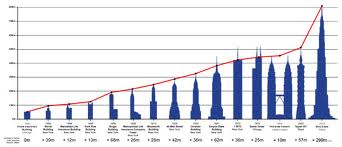Last night while surfing the net I stumbled across a story I had not known before. A 3,445 foot tall, 189 story skyscraper (Azerbaijan Tower) is planned in the Central Asian city of Baku, Azerbaijan. Needless to say, it would be the tallest skyscraper on the planet by a hefty margin as the world’s current reigning super-scraper Burj Dubai (Khalifa) in Dubai is 2,722 feet high.
While I am pleased that Azerbaijan is doing so well economically (apparently from oil revenues) that they can afford to build such an immense tower, a part of me wonders whether its impractical and more an example of skyscraper envy than an actual real need based on demand. The thought of such a tower harkens one to 1960s cartoon, The Jetsons where everyone lived in such super tall skyscrapers and moved about busily in flying cars. In what may be a harbinger of a future evolutionary change for ornithology, there was a scene in one episode where a bird had totally given up trying to fly amid the sky’s congestion and was instead walking on the ground.
For a short history of the world’s tallest building, between 1931 and 1972, the New York City’s Empire State Building was the world’s tallest building at 1,250 feet, followed briefly by the twin towers of the World Trade Center at 1,350 feet. Then Chicago’s Sears (Willis) Tower surpassed them at 1,450 feet. It held the record for 24 years. Since then, there has been a new record tall tower erected approximately every six years, first in Kuala Lumpur in 1998, then Taipei in 2004, and then Dubai in 2010. As the pace of change has quickened, so have the eye-popping heights until the planned tower in Baku would reach more than a kilometer into the Central Asian sky.
Given the unyielding rise of the super-scraper, one has to wonder a few things:
- How tall is too tall? This can be from an economic standpoint, a practicality standpoint, or a safety standpoint. Good luck fighting a fire in a 160-190 story building – anyone remember the 1974 movie Towering Inferno?
- Are these super-scrapers fulfilling an actual need or are the more designed to satisfy an ego (individual, corporate, or national)? I will readily admit, as a kid I thought it was cool that we had the world’s tallest building in the United States. Today – I am more interested in the artistic and architectural features of the skyscraper and its relationship to its surroundings more than its ultimate height. Quality versus quantity, you might say.
- How far up into the sky will this skyscraping trend extend? a mile? multiple miles?
- Couldn’t the vast amounts of money spent designing and constructing a super-scraper be better used for socioeconomic and humanitarian purposes?
To me, there seems to be an identifiable historic precept that says:
- When nations go through a rapid economic transformation, they begin constructing massive projects whose scale may or may not be tied to a measurable need.
This is not to say that the project is a complete waste of money and resources, but instead that certain portions of the project that go well above and beyond the actual need may be wasteful. Examples could range from linking two land masses by bridge or tunnel, providing water for irrigation and consumption by damming a river, constructing airports the size of small countries, starting outer space programs, or filling a need for office space. In the United States, some of these took place as we went from being a rural and/or agrarian society to an urban industrialized one. Similar examples of transformative nations can be seen with Japan, China, India, Malaysia, Thailand, Brazil, the United Arab Emirates, and other countries. There are also a few examples of pretenders who participate as a wannabe rather than an actual contender – East Germany was an example during the Cold War.
In 2013, it appears to be Azerbaijan’s turn to step onto the world stage. The question is, will its fame be a fleeting 15 minutes, or will it be more permanent and sustainable – only time will tell future historians that answer.



Damn! I gotta stay with THIS! Thanks, Rick!
LikeLike
LOL – thanks, Basil.
LikeLike
You ARE welcome.
LikeLike
I recently saw something on Frontline (I think) discussing the “Skyscraper Index”. It hypothesizes that the completion of world’s tallest buildings are signals of the ends of economic cycles. Very interesting and thanks for the post.
LikeLike
Thank would be interesting. Thanks, Dan. I will see if I can find it online.
LikeLike
I think when steel transportation systems and steel frame buildings first appeared, they enhanced property values in the rapidly emerging CBDs. Being at the center of the densest concentration of people made sense for the most expensive buildings. In the present era of post fordist production systems and rapidly expanding communication systems that allow the deconstruction of industry, it seems like the skyscraper is either a monument to cities of the past or an expensive status symbol. Does anyone really need all that office space at that location?
LikeLike
I totally agree.
LikeLike
Pingback: My Homepage
My goodness, has the goal of everything to excess spread further?
LikeLike
Apparently so, Terry. Apparently so.
LikeLike